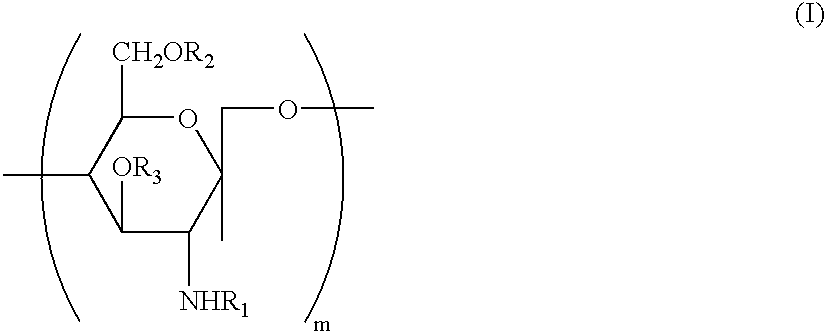Water soluble, randomly substituted partial N-partial O-acetylated chitosan, preserving compositions containing chitosan, and processes for making thereof
- Summary
- Abstract
- Description
- Claims
- Application Information
AI Technical Summary
Benefits of technology
Problems solved by technology
Method used
Image
Examples
example 2
[0099] This example illustrates the activity of different hydroxyalkyl chitosan solutions against Escherichia coli in a 28 day USP Preservative Efficacy Test (PET). Solutions 2a-e were prepared as described in Example 1, using the following recipe.
example formulations # 2a-e
Example Formulations #2a-e
[0100] 0.05% EDTA
[0101] 1.00% Boric Acid
[0102] Ultrapure Water (q.s. adj 100.00 mL)
[0103] 0.5M Sodium Hydroxide(q.s. adj pH=6.9)
[0104] Sodium Chloride (q.s. adj mOsm=300)
[0105] a: control; b=0.25% glycol chitosan (SIGMA Chemical); c=0.25% hydroxypropyl chitosan (Austin Chemical Co.); d=0.25% hydroxybutyl chitosan (Austin Chemical Co.); e=0.25% di-hydroxypropyl chitosan (Technology Resource International Corporation).
[0106] The conditions of the PET were the same as those for Example 1 except that a re-challenge inoculum was not introduced at day 14. For this test, E. coli only was chosen as the screening microorganism because earlier tests showed that it was typically more resistant than other PET bacteria to chitosan antimicrobial formulations. Thus, antimicrobial activity against E. coli was deemed predictive of efficacy against the other PET microorganisms.
[0107] Referring to Table 2, it can be seen that all of the test solutions met the requirements of ...
example 3
Formulations
[0109]
6 Glycol chitosan (Sigma Chemical) 0.5% Pluronic .TM. F68 (BASF Corporation) 0.05% EDTA 0.05% Sodium borate decahydrate 0.08% Boric acid 0.72% Ultrapure Water q.s. adj 100.00 mL Sodium hydroxide solution (0.5 M) q.s. pH = 6.6, 7.2 or 7.8 Sodium chloride q.s. mOsm = 300 .+-. 10
[0110]
7TABLE 3 Comparison of the antimicrobial activity of Example 3 against Pseudomonas aeruginosa Cfu Pseudomonas aeruginosa after 24 hours.sup.1,2 PH = 6.6 pH = 7.2 pH = 7.8 2 184 >1000 Notes: .sup.1Challenge inoculum was 10.sup.6 cfu / mL .sup.2Data shown is from the 10.sup.5 cfu recovery plates
[0111] The table above shows the average number of surviving colonies on the 10.sup.5 recovery plates that were prepared 24 hours after challenging the test formulations with 106 cfu / mL Pseudomonas aeruginosa. As can be seen from this data, the pH 6.6 and 7.2 formulations of glycol chito san were more effective in killing P. aeruginosa in 24 hours than the glycol chitosan formulation at pH=7.8.
Example...
PUM
| Property | Measurement | Unit |
|---|---|---|
| Fraction | aaaaa | aaaaa |
| Time | aaaaa | aaaaa |
| Acidity | aaaaa | aaaaa |
Abstract
Description
Claims
Application Information
 Login to View More
Login to View More - R&D
- Intellectual Property
- Life Sciences
- Materials
- Tech Scout
- Unparalleled Data Quality
- Higher Quality Content
- 60% Fewer Hallucinations
Browse by: Latest US Patents, China's latest patents, Technical Efficacy Thesaurus, Application Domain, Technology Topic, Popular Technical Reports.
© 2025 PatSnap. All rights reserved.Legal|Privacy policy|Modern Slavery Act Transparency Statement|Sitemap|About US| Contact US: help@patsnap.com



